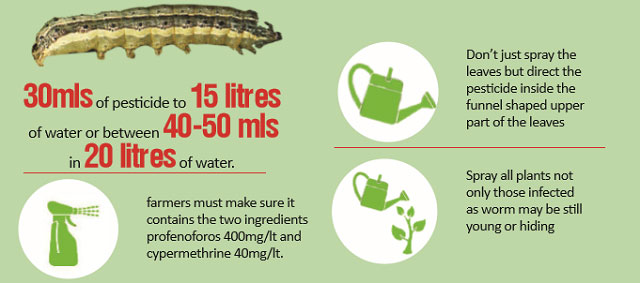
Stealth eater
The armyworm arrives in the night in the belly of multitudes of gray and brown moths that recently popped up in maize gardens across the country. With nobody paying attention, the moths laid up to 1500 eggs per female in clusters under the maize leaves and moved on. Four days later the eggs, still unwatched, hatched tiny greenish caterpillars with black heads which immediately started feeding on the thin layer of the underside of the leaf to avoid the sun and detection. But by week two the caterpillars had grown to about half a man’s middle finger in length, with a thick whitish brown body and a reddish head bearing an inverted `Y’ mark. Unsatisfied with the thin layers of the underbelly of the leaf, the caterpillar soon pierced thousands of holes in the maize leaves, ears, and cobs. Since they fed mainly in the morning and evening when it was cool and the farmers were away, it was weeks before they were detected.
Older larvae cause extensive defoliation often leaving only the stalks of the maize plants. On some fields, the larvae also burrowed into the growing point ‘bud’ of the maize and destroyed it. The larvae feed on basically every part of the maize except the roots. The larvae eat the leaves, concentrating on the funnel-like areas formed by leaves. They also dig into the ears and even maize cobs. This means the maize is at risk at all stages. This goes on for between two weeks and one month when the caterpillars morph into the pupa stage in readiness to become adult moths and restart the cycle.
Finally the MAAIF did a demonstration on fighting the army worn on Ddumba’s farm. But the worms remain. Ddumba says they might have become resistant to the drugs. He says he has settled to using only Stryker.
“But I am also trying out several pesticide combinations,” he says.
A Ugandan agricultural scientist, Dr. John W. Bahana, who runs an agricultural consultancy, says the government should not have been caught unawares if it was running an Integrated Pest Management (IPM) system.
Bahana, wrote in a newspaper article, that he has 30 years of fighting armyworms under his belt. He is an expert in this area because he first worked at Uganda’s top agriculture research body, the Kawanda Research Station near Kampala and returned from doing similar work in Zambia. He explains that under IPM, traps fitted with chemicals that mimic sex emitting characteristics of insects are routinely deployed to capture insects from a distance as far as 20kms away.
“High numbers of male moths in the trap; say above 50 each night, will signal an outbreak,” he says.
He says the scientists would then collaborate with meteorologists to determine the cause of the high number of moths as they may have been caused by wind convergences. In any case, he says, outbreaks will be registered in an area seven days after arrival of the moths.
“The rest is no technical stuff,” he says and outlines some procedures; the farmers are alerted by local officials to search for the small worms, pesticides are supplied to as near the outbreak as possible, and farmers are trained on how to spray against the marauding insects.
None of that happened this time. The question now is whether the government will be better prepared for such an invasion next time. Scientists have been warning of this and since, as Bahana says, the fall armyworm is a cousin of the African armyworm, it could become endemic to the region.
Governments warned
In April 2016, several scientists working under several big-name global research organisations published a paper entitled `Global threat to agriculture from invasive species. The paper, which was edited by Harold A. Mooney and published in the journal, Proceedings of the National academy of sciences, surveyed 1300 pests to assess their potential to move across the globe and invade new territories. They warned that invasive species, such as the armyworm, threaten global agriculture.
“Overall, the biggest agricultural producers (China and the United States) could experience the greatest absolute cost from further species invasions,” the scientists wrote, “However, developing countries, in particular, Sub-Saharan African countries, appear most vulnerable in relative terms”.
In the survey, Uganda was ranked to be at very low risk compared to Ethiopia, Kenya, and Mozambique. But that was partly because the research based their extrapolations on global trade linkages of which Uganda has few. But Uganda should have been better prepared because the invasion of the armyworm is the second major biological attack on the country in about 20 years. The other was the water hyacinth which devastated Lake Victoria between 1992 and 1998.
Lack of vigilance means the exact time the army worn reached Uganda remains mysterious. Though some reports talk of September and October 2016, MAAIF in its statement says the worms were first reported in May 2016 with farmers in Kayunga, Kesese, and Bukedea reporting ‘’caterpillars’’ that were destroying their maize. However, other reports say the worms were active in Uganda as early as March 2016. That would mean it took the government a whole year to confirm the outbreak. It would also be an indictment on the breakdown of the agricultural extension service. But Minister Ssempijja is defensive.
“This is a new pest and we had to do tests in laboratories here and abroad to confirm what it was before we could announce the outbreak,” he says.
What is known now is that the Fall Armyworm is a native of the western hemisphere; from the United States to Argentina. In the U.S. it is predominant in the south of the Florida and Texas states. But the fall armyworm, scientifically called Spodoptera frugiperda, is a strong flier and the moth can cover up to 2000Kms annually. That is how it gets about. It remains a mystery, however, how the worm crossed the Atlantic into Africa. A statement by MAAIF on March 27 said it could have been imported in agricultural produce.
In Africa, it was first reported in Nigeria in January 2016. Outbreaks have since been confirmed in Togo, Ghana, Zambia, Zimbabwe, South Africa, Malawi, Mozambique, Namibia, Kenya, Tanzania and Uganda.
It gets the “army” in its name because of the marching behavior of its larvae or caterpillar stage which destroy whatever vegetation is in their wake completely before moving on to the next area. The ‘fall’ has to do with the season they thrive in best in their native home. The larvae in fact love cool weather and can last in that state for 30 days when it’s cooler and only 10 days in warmer weather. That rhymes with the life cycle of the worm, which is between 30 and 90 days.
****
editor@independent.co.ug
 The Independent Uganda: You get the Truth we Pay the Price
The Independent Uganda: You get the Truth we Pay the Price



Going by reports in the media, the devastation caused by this worm is already catastrophic. The spillover effects of this invasion and the consequent reduction of the would be maize harvests is likely to affect national food security. Already, the prices of maize and other cereal foods and products are up given the distress situation the country has been through.
If the government, as indicated in this article, was caught unaware, it will be a shame if adequate plans to contain the likely food shortages are not discussed and mitigation measures put in place.
For its true that Uganda was experiencing an outbreak of new pest and diseases because of climate change and climate variabilities which would negatively impact the nation’s food & nutrition security and wealth-creations effort.
On seeing the climate change,we cud ask ourselve that,our are we going to leave in the next couples of years if this #army_worm contineous in our country?
About all lets put our country into prayer cos everything is posible from our God,